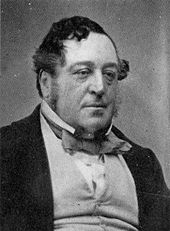|

Early photograph of Gioachino Rossini (Ransom Humanities Research Center, The University of Texas at Austin)
The William Tell Overture is the instrumental introduction to the opera Guillaume Tell (in English, William Tell) by Gioachino Rossini. William Tell premiered in 1829 and was the last of Rossini's 39 operas, after which he went into semi-retirement, although he continued to compose cantatas, sacred music and secular vocal music. The overture is in four parts, each following without pause. There has been repeated use (and sometimes parody) of parts of this overture in both classical music and popular media, most famously as the theme music for the Lone Ranger radio and television shows. Franz Liszt prepared a piano transcription of the overture in 1838 (S.552) which became a staple of his concert repertoire. There are also transcriptions by other composers, including versions by Louis Gottschalk for two and four pianos and a duet for piano and violin.
Instrumentation
The overture is scored for: a piccolo, a flute, two oboes (first or second oboe doubles a cor anglais), two clarinets in A, two bassoons, four horns in G and E, two trumpets in E, three trombones, timpani, triangle, bass drum and cymbals, and strings.
Structure
The overture, which lasts for approximately 12 minutes, paints a musical picture of life in the Swiss Alps, the setting of the opera. It was described by Berlioz (who usually loathed Rossini's works) as "a symphony in four parts", but unlike a symphony with its discrete movements, the overture's parts transition from one to the next without any break.
- Prelude, Dawn
The Prelude is a slow passage in E major, scored for five solo cellos accompanied by double basses. It begins with a solo cello which is in turn 'answered' by the remaining cellos and the double basses. An impending storm is hinted at by two very quiet timpani rolls resembling distant thunder. The section ends with a very high sustained note played by the first cello.
- Storm
This dynamic section in E minor is played by the full orchestra. It begins with the violins and violas. Their phrases are punctuated by short wind instrument interventions of three notes each, first by the piccolo, flute and oboes, then by the clarinets and bassoons. The storm breaks out in full with the entrance of the horns, trumpets, trombones, and bass drum. The volume and number of instruments gradually decreases as the storm subsides. The section ends with the flute playing alone.
- Ranz des Vaches or "Call to the Cows"
This pastorale section in G major signifying the calm after the storm begins with a Ranz des Vaches or "Call to the Cows", featuring the cor anglais (English horn). The horn then plays in alternating phrases with the flute, culminating in a duet with the triangle accompanying them in the background. This segment is often used in animated cartoons to signify daybreak, most notably in Walt Disney's The Old Mill.
- Finale
The Finale, "March of the Swiss Soldiers", is an ultra-dynamic "cavalry charge" gallop heralded by trumpets and played by the full orchestra. It is in E major like the Prelude. This segment is often used in popular media to denote galloping horses, a race, or a hero riding to the rescue. Its most famous use in that respect is as the theme music for the Lone Ranger-so much so that an intellectual has been defined as "a man who can listen to the William Tell Overture without thinking of the Lone Ranger." The Finale is also quoted by Dmitri Shostakovich in the first movement of his Symphony No. 15.
Cultural References
Described by David Wondrich as a "frequent target of plunder by brass bands in the years during which they dominated the American musical landscape", the overture features prominently in Walt Disney's Mickey Mouse cartoon, The Band Concert. It has also been used in cartoons parodying classical music (e.g. Bugs Bunny's Overtures to Disaster in which the overture's finale is performed by Daffy Duck and Porky Pig) or Westerns (e.g. Bugs Bunny Rides Again). In Yankee Doodle Daffy, the title character even gives lyrics to the finale.
One of the most frequently used pieces of classical music in American advertising, the overture (especially its finale) appears in numerous ads, with psychologist Joan Meyers-Levy suggesting that it is particularly suitable for those targeting male consumers. It was used in a hip-hop version by DJ Shadow to accompany the 2001 "Defy Convention" advertisement campaign for Reebok athletic shoes, in an electronic version for a 2008 Honda Civic campaign and the video game Catherine.
During the third time-out of every second half at Indiana University basketball games, the Indiana pep band and cheerleading squad performs the William Tell Overture with cheerleaders racing around the court carrying a myriad of eighteen flags. Indiana public address announcer Chuck Crabb said the tradition began in about 1979 or 1980. Sportscaster Billy Packer called it "the greatest college timeout in the country."
For More Information:
Gioachino Antonio Rossini
|